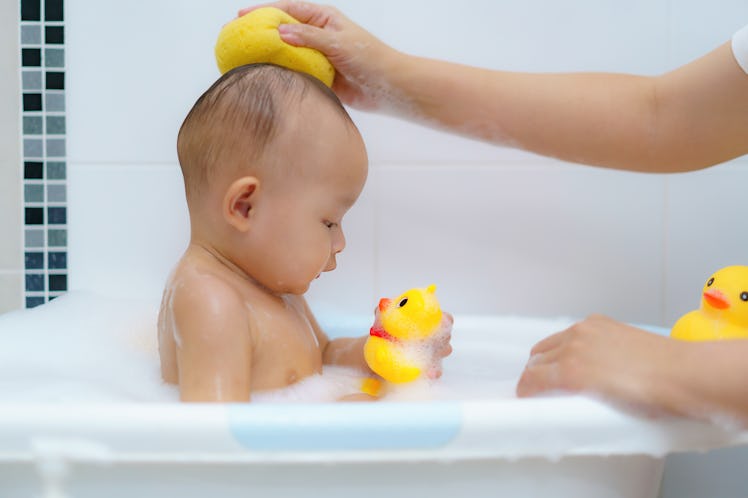How To Clean Bath Toys, Which Have More Mold Than You Think
Bath toys are a pain to clean, but it can be done. However, it’s better to prevent them from getting moldy to begin with.

The problem with bath toys generally isn’t on the outside. The plastic feathers of a rubber ducky look clean because, by and large, they are (assuming no one has been peeing in the tub). But the inside is another matter. Bath toys don’t really dry out. They have no air circulation, and because they’re opaque, light doesn’t dry them out. That means the inside of a bath toy is damp and dark, ideal for growing mold. That light gray stain around the polar bear’s toes? Mold. That strange discoloration at the tip of the rubber ducky’s tail? Mold. And what’s worse, it won’t stay in there. Bath toys are not only cultivators of mold, but conduits to the mouths of infants and toddlers. So parents need to know how to clean bath toys to keep mold out of their little one’s mouth.
“Taking care of the squeaky toys can be really tricky because of the small hole at the bottom and hard-to-reach surfaces inside,” says Lily Cameron, the resident cleaning expert at London’s Fantastic Services and a professional cleaner of twelve years. “Start with squeezing out all of the excess water inside. Then place the toys in a solution of three parts hot water and one part white vinegar — you can either use the bathroom sink or a large bowl. Let it soak for at least ten minutes, then rinse thoroughly with plain water, and let it completely dry.”
There are some who advocate for using bleach, but Cameron isn’t one of them. “There is another approach with bleach and water,” she explains. “But I wouldn’t recommend it since bleach can be harmful to use.” Harsh cleaners in general aren’t a great mix for the baby’s bath.
If parents can’t quite shake the willies of having black mold lurking in their bath toys, there are other options than throwing all of the toys on the grill and giving them a Viking funeral. That’s good for families with kids who are reluctant to bathe, since bath toys may be the only way to bribe the kid back into the tub.
Those options are: Parents can either prevent water from getting into the toy in the first place, or modify the toys to make them easier to clean. Both are quick and easy to do.
To seal a new toy from getting water inside and growing mold, a drop of hot glue can plug the hole. This is a good option if the toy is particularly large or has a lot of nooks and crannies in its design that makes it hard to clean. It doesn’t really affect the toy; it may be less squeezable, or no longer be able to squeak or squirt water, but that won’t really matter to kids. They don’t need any help splashing water out of the tub anyway.
Even sealed toys should be cleaned occasionally, however, to make sure the outside doesn’t get moldy. “Every few weeks, you can scrub the toys in hot water with an old toothbrush or a dish scrubber,” Cameron says.
Another option is to drill the holes larger so that they’re easier to clean. A 3/16” or 1/4” drill bit should work. That’s wide enough to fit a pipe cleaner for scrubbing and a cotton swab or rolled-up piece of paper towel for drying. This method has the added bonus of leaving the ability of the toy to squirt water unaffected, although it will up the volume of the stream. But the toys need to be maintained — if mold is allowed to grow inside because the toy isn’t cleaned, it’s likely parents will see chunks of mold floating in the bath water next time the toy is squeezed.
With the proper maintenance, there’s no reason for bath toys to be gross. That’s good, because bath toys are awesome, and it’s hard to imagine bath time without them.
This article was originally published on